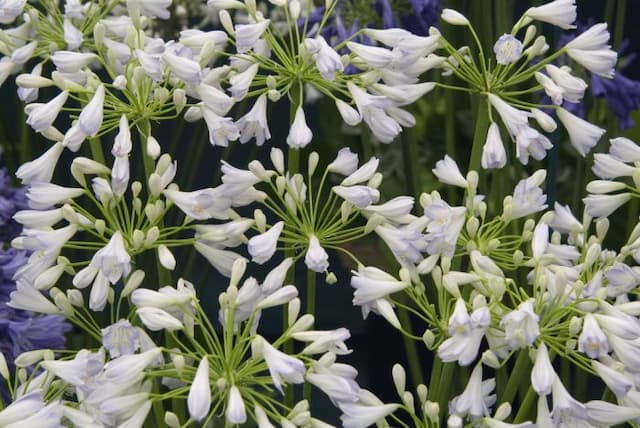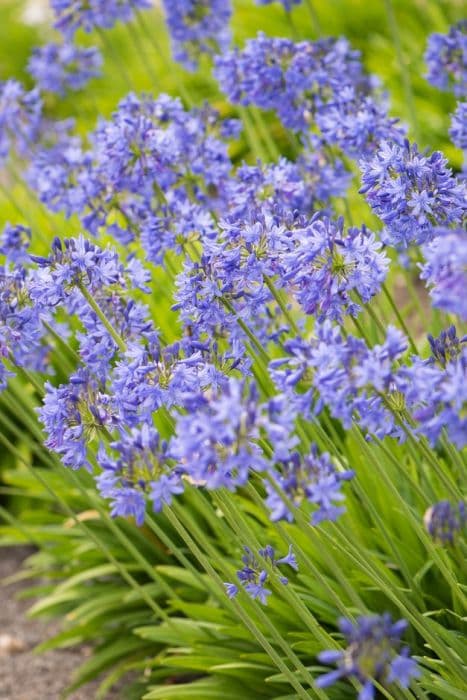Lily of the Nile Agapanthus 'Marjorie'

ABOUT
Agapanthus 'Marjorie' is characterized by its striking appearance, often making it a focal point in gardens and landscapes. The plant produces lush, strap-like, green leaves that form a dense clump, giving it a full and somewhat arching appearance. The foliage offers a backdrop to the main attraction: the spectacular flowers. The blooms of Agapanthus 'Marjorie' are borne on tall, sturdy stems that rise above the foliage. Each stem culminates in a spherical cluster of individual funnel-shaped flowers. These flowers are typically a deep violet-blue hue, which can vary slightly in intensity, creating a beautiful contrast against the verdant green leaves. The flower clusters are large and eye-catching, resembling globes of color that sway gently with the wind. Each petal of the flowers is soft and slightly recurved, contributing to the overall roundness of the bloom clusters. Within each flower, subtle striations or a gradient of color might be apparent, adding depth and texture to the visual presentation. Agapanthus 'Marjorie's' blooms last for several weeks, usually in the peak of the summer months, providing a long-lasting display of color. After the flowering period, the plant may produce seed heads that add another layer of interest to its appearance. Throughout the seasons, Agapanthus 'Marjorie' maintains its foliage, making it a good choice for year-round greenery in suitable climates. The combination of the vibrant, spherical flower heads and the dense clumps of green foliage creates a lush, exotic, and somewhat tropical appearance that can enhance a variety of garden settings.
About this plant
 Names
NamesFamily
Amaryllidaceae
Synonyms
African Lily, Lily Of The Nile, Love Flower
Common names
Agapanthus 'Marjorie'
 Toxicity
ToxicityTo humans
The Agapanthus, commonly known as the Lily of the Nile or African Lily, has parts that are considered to be toxic if ingested. While it is mostly a concern for pets, it can cause gastrointestinal symptoms like nausea, vomiting, and diarrhea in humans. Ingesting large quantities may lead to more severe reactions and medical attention should be sought if symptoms are severe or persist.
To pets
The Agapanthus, commonly known as the Lily of the Nile or African Lily, is toxic to pets if ingested. The plant contains substances that can cause vomiting, diarrhea, and salivation in dogs and cats. If ingesting the plant has occurred, it is advisable to promptly consult a veterinarian. In severe cases, ingestion may lead to lethargy or more serious symptoms, so monitoring pets closely after ingestion is important.
 Characteristics
CharacteristicsLife cycle
Perennials
Foliage type
Evergreen
Color of leaves
Green
Flower color
Blue
Height
2 feet [60 cm]
Spread
2 feet [60 cm]
Plant type
Bulb
Hardiness zones
8
Native area
South Africa
Benefits
 General Benefits
General Benefits- Ornamental Appeal: The Agapanthus 'Marjorie' or Lily of the Nile, features striking blue/purple flowers that add a beautiful aesthetic to gardens and landscapes.
- Drought Tolerance: Once established, it has good resistance to periods of drought, making it suitable for water-wise gardens.
- Low Maintenance: It requires minimal care once settled into its location, making it ideal for gardeners of all levels of experience.
- Attracts Wildlife: The flowers can attract pollinators such as bees and butterflies, enhancing biodiversity in the garden.
- Long Blooming Season: It offers a long flowering season, usually from spring to summer, providing color and interest for an extended period.
- Container Gardening: Suitable for pot culture, it can be grown in containers for patios, balconies, or to accentuate entryways.
- Soil Adaptability: It can adapt to a wide range of soil types, though it prefers well-draining soil.
- Border Planting: Its clumping habit and upright flower stalks make it an excellent choice for borders or as a focal point in garden beds.
 Medical Properties
Medical PropertiesThis plant is not used for medical purposes.
 Air-purifying Qualities
Air-purifying QualitiesThis plant is not specifically known for air purifying qualities.
 Other Uses
Other Uses- The Agapanthus can be utilized as an ink or dye source. The sap contains pigments that can be used for dyeing fabrics or crafting homemade inks.
- They are excellent in teaching botanical concepts. Due to their distinctive flower structure, they can be used to educate individuals about plant morphology and reproduction.
- Their fibrous roots can be useful in erosion control. Planting them on slopes can help to stabilize soil and prevent erosion.
- Agapanthus serves as a barometer plant. Since they close up when rain is approaching, they can be used to predict impending wet weather.
- They can be used in art for flower pressing. Their sturdy and colorful flowers make them ideal for creating pressed flower arrangements or bookmarks.
- As part of a sensory garden, the plants can be utilized for their texture. The leaves and flower stalks offer unique tactile experiences for educational or therapeutic gardens
- They could be used in ikebana, which is the Japanese art of flower arranging that emphasizes shape, line, and form.
- The seed pods can be used for crafts or as natural ornaments. After the blooming period, the dried seed heads can be attractive in arrangements or as part of wreaths.
- Agapanthus flowers can be used as a natural pH indicator. The blue flowers can indicate the presence of acidic compounds when used in certain experimental settings.
- In photography, the Agapanthus's striking blooms make it a popular subject for botanical photographers and for those looking to add a pop of color to their portfolio.
Interesting Facts
 Feng Shui
Feng ShuiThe Agapanthus is not used in Feng Shui practice.
 Zodiac Sign Compitability
Zodiac Sign CompitabilityThe Agapanthus is not used in astrology practice.
 Plant Symbolism
Plant Symbolism- Love Letters: The name "Agapanthus" is derived from the Greek words 'agape' meaning love, and 'anthos' meaning flower. Together, they symbolize love letters or a message of love.
- Beauty: Agapanthus, known commonly as the African Lily, is admired for its stunning blue to violet flower clusters, symbolizing beauty and a graceful presence.
- Strength and Durability: The African Lily is a hardy plant that withstands tough conditions, symbolizing strength, survival, and resilience.
- Fertility and Fecundity: Due to its lush growth and abundant blossoms, it can symbolize fertility and the creation of life.
- Freedom: The long, slender stalks of the Agapanthus allow the clusters of flowers to sway freely in the breeze, this movement symbolizes freedom and an unrestrained spirit.
 Water
WaterThe Lily of the Nile should be watered once a week with about 1 inch of water, which translates to about 0.623 gallons per square foot, ensuring that the soil is moist but not waterlogged. During hotter and drier months, the frequency may need to increase to maintain consistent soil moisture. Reduce watering in the winter when the plant is dormant. It's important to water the plant at the base to avoid wetting the foliage, which can promote disease.
 Light
LightLily of the Nile thrives best in full sun to partial shade. The ideal spot for this plant is an area where it can receive at least six hours of direct sunlight daily, with some afternoon shade in hotter regions to prevent sunburn.
 Temperature
TemperatureLily of the Nile prefers a temperate climate with temperatures ranging between 50°F and 80°F for optimal growth. It can tolerate a minimum temperature of 20°F, however, frost can damage the foliage. The ideal temperature range is 60°F to 70°F, which promotes healthy growth and flowering.
 Pruning
PruningPrune Lily of the Nile after it finishes blooming to remove spent flower stalks, which encourages new growth and can lead to a second bloom. It's best to prune in the late fall or early spring. Cut the stalks down to the base, and remove any dead or damaged leaves to maintain plant health and appearance.
 Cleaning
CleaningAs needed
 Soil
SoilAfrican Lily 'Marjorie' thrives best in a soil mix with good drainage, like a blend of loamy soil, compost, and perlite or coarse sand. A slightly acidic to neutral pH range of 6.0 to 7.0 is ideal for this plant.
 Repotting
RepottingAfrican Lily 'Marjorie' should be repotted every 2-3 years to ensure it has enough room to grow and to refresh its soil, ideally in spring just before the growing season.
 Humidity & Misting
Humidity & MistingAfrican Lily 'Marjorie' does best in average humidity conditions and does not require any special humidity adjustments when grown in most household environments.
 Suitable locations
Suitable locationsIndoor
Place in bright, indirect light and water when the topsoil dries.
Outdoor
Plant in partial shade to full sun and protect from severe frosts.
Hardiness zone
8-10 USDA.
 Life cycle
Life cycleAgapanthus 'Marjorie', also known as Lily of the Nile, begins its life cycle as a seed which, when planted in spring in warm climates or early summer in cooler regions, germinates and develops into a seedling. The seedling grows into a vegetative plant with strap-like leaves and establishes a strong root system. As the plant matures, typically taking several years, it forms clumps that can be divided. During the flowering period in summer, it produces tall stalks topped with clusters of trumpet-shaped flowers, which are usually blue, purple, or white depending on the cultivar. After pollination, the flowers produce seed pods that mature, dry out, and release seeds to complete the cycle. In non-tropical climates, the plant enters a dormancy phase during the winter, where the foliage may die back, to re-emerge in the spring.
 Propogation
PropogationPropogation time
Spring-Early Summer
Agapanthus 'Marjorie', commonly known as Lily of the Nile, is most frequently propagated by division, which is a method of asexual propagation. The best time to propagate by division is in the spring or early summer, when the plant is emerging from dormancy and beginning active growth. To propagate, carefully lift the clump from the ground using a garden fork, then gently tease apart the roots to separate individual plants, ensuring each has a portion of the roots and at least one or two growing points. These divisions can then be replanted immediately in well-preparing planting holes, spaced about 18 inches (approximately 45 centimeters) apart, to allow adequate room for growth. Water the new plants thoroughly after planting to help establish them. Dividing every three to four years also helps to rejuvenate the plant, as over time, the center of the clump may become woody and less floriferous.









